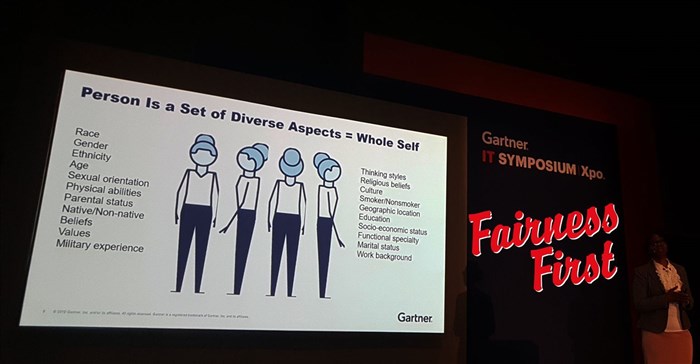#FairnessFirst: Test your unconscious bias for a more diverse and inclusive work culture, today!

Griffin said to start with small actions you can use today and then scale with your business partners over time.
This has proven effective in Gartner's CIO Research group, which creates actionable and applicable research, focused on leadership and learning development by exploring concepts related to team development, management and leadership skills development and self and team motivation.
Doing so provides an exponential business advantage over your competitors in attracting top talent, improving the customer experience you offer as you have more diversity behind the scenes, which also leads to better opportunities for innovation, so why isn’t everybody doing it?
D&I guidelines for 2020 and beyond
Griffin said the answer is simple: While some are constantly looking to improve and move forward in this direction, unfortunately, many are stuck at the talking phase, without moving on to action.
Explaining what diversity and inclusion or D&I means as we approach 2020, Griffin said a core change is that there's no longer just focus on the physical appearance.
Instead, diversity now includes different backgrounds and experiences, as well as different values and preferences. Inclusion, on the other hand, is about creating a safe environment in which to be treated fairly, respectfully and contribute equally.
We have to ask whether it's truly safe to fail in our organisations.
Up the age and digital diversity
If there are extreme consequences for this, there's likely to be less willingness to innovate and less inclusion than you'd like.
Inclusion is more important than ever, said Griffin. Just think of how gender descriptions have been updated over the past decade to show more depth.
Age is another factor to consider, as people are starting to work earlier and staying in the workforce for longer.
This means that the work behaviours of different generations in the workplace need to be anticipated, as well as how to effectively lead teams that are a mix, without letting the inexperienced tech-enabled younger set feel they can't contribute, or the legacy staff worry that they're being pushed out of the workforce.
That links to Griffin's next point - that digital diversity is growing in importance, as we realise that digital dexterity - defined as aptitude and attitude to technology and all things digital, will vary across teams.
Why you should take an unconscious bias test
Griffin commented that while there's a push towards being more intentional about including diversity across industries, when it comes to inclusion this can be difficult, as layers of unconscious bias can hide certain views and values that run beneath the surface in the company.
If you don't fit in, you stand out.
Not that that's always a bad thing. It's all in how you handle it, and how others interact with you.
That said, Griffin mentioned that we all have blind spots and experiences that colour the way we view the world. She recommends taking a free unconscious bias test online.
Unless you're highly trained in the subject and have dealt with the issues that arise, if you are human, you're biasedGriffin said this is part of survival, as we take in 11 million pieces of information per second, but are consciously aware of just 40 of those as we filter out the rest.
Back to basics to minimise bias in the hiring process
To minimise the bias in your workplace, Griffin said to start with the basics:
- Look at your job descriptions for bias. Do you include 'nice to have' personality attributes over what is actually needed to get the job done, as that's what you're hiring for?
- Ensure there's diversity sitting in on the interview process.
- Do your research to make sure the final offer is equitable, based on the current market rate.
- Relook at your current succession planning policies and how you identify high-potentials internally. Is there equal opportunity to rise to the next level for all? If not, what can you do to improve accessibility?
Griffin also said you can identify a good leader internally when others keep asking to join their team - that's usually a sign of inclusivity.
Support through mentors and sponsors
When it comes to succession planning, Griffin recommends assigning mentors to help employees develop in their current role, and sponsors to help them reach their future aspirations.
Also keep in mind that the words we use matter, and train your leadership team to recognise and confront behaviours that marginalise team members.
Watch the #GartnerSYM hashtag for further coverage of the Gartner Symposium.


















